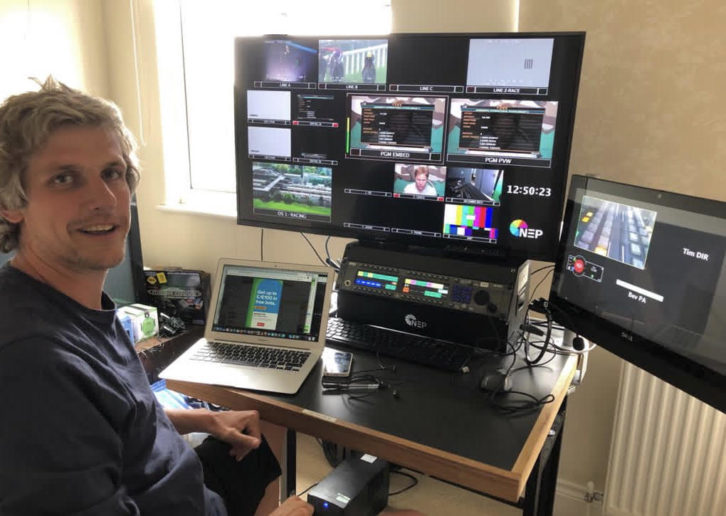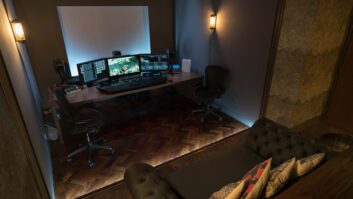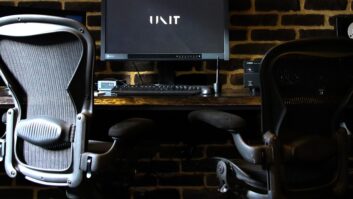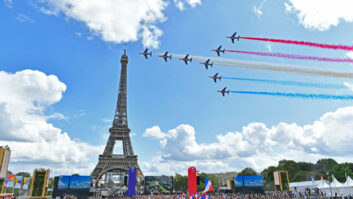In the days preceding the resumption of horse racing in the UK, ITV Sport had developed plans that would enable its production teams to broadcast the events, while still adhering to the coronavirus restrictions in place at the time.
“After a barren period for TV sport, we wanted to be ready to provide viewers with the best coverage possible under the conditions – and we were prepared,” states BAFTA Award-winning director, Paul McNamara. “And those plans involved as many of the team working from home as was deemed possible.”
He goes on to say that his first experience of directing from home was for ITV’s main channel and included coverage of the prestigious 1000 and 2000 guineas races from Newmarket. “This was an important date in the horse racing calendar and it was, therefore, a really big show.”
As well as McNamara, the producer, production assistant and presenters were all operating from their homes. The vision mixer was also remote – but in an OB van parked at another famous racecourse, Ascot.
McNamara already had experience of directing remotely, albeit from a studio gallery. This included the FIFA World Cup in Brazil and the Rugby World Cup in Japan.
“There are massive differences between home and gallery directing. When directing at home you have no technical support. You are completely isolated in your spare bedroom with a multiviewer and talkback panel. Yes, both in home and gallery directing are remote – but they are different operations – in fact, as different as chalk and cheese,” he says.
Equipment
The multiviewer set up at McNamara’s home allowed him to see TX and what the vision mixer had on the preview bank. As well as the individual camera feeds and VT, there were individual sources for the presenters and guests. Talkback was provided to all the normal sources. “But, just as important,” explains McNamara, “I had a computer next to the monitor on which a Zoom grid was displayed. I could see the faces of the producer, vision mixer, PA and others. That came in very useful when my multiviewer screen crashed in the middle of a programme. I could ask on Zoom if the others had also lost the feeds – and when they all said they were OK, I had to plan the next sequence without the benefit of seeing the sources. But I could see, via Zoom, that the vision mixer was across what I was saying.”

In fact, crashes occurred on three occasions. “That’s what happens when you are relying on broadband. There are external influences outside of your control that can affect what is going on.”
He goes on,” Obviously you do your planning as if you were in a studio gallery – but it can take a lot longer. For example, our programmes were due to go to air at 1pm, but we all started switching on equipment at about 9am. We all needed to make sure WiFi was working and talkback was operational. You cannot take anything for granted when you are working from home.”
Useful tip
McNamara says that one vital factor when working under remote conditions is the importance of presenters not asking open questions. “In a studio situation, you can see by eye contact to whom a question is being addressed. That obvious doesn’t work remotely. If a question is not put to a specific person, everyone might start answering. Then everyone realises the others are speaking – and all stop. Not very professional. We quickly learned at rehearsals that the presenter must say ‘Now xxx, what do you think of such and such horse?’. Then just one person answers. Much better!”
He adds, “It is a great testament to all involved that the coverage went extremely well. I am really proud of what was achieved through hard work and dedication of the team. Of course, one of the best things about working remotely in this way is the journey back home at the end of the day. Just down the stairs.”
Magazines, too
Linked to the coverage of the racing is The Opening Show, a weekly one-hour magazine show broadcast on Saturday mornings on ITV4 and every day throughout major festivals such Royal Ascot, Grand National, Cheltenham. The show previews the day’s racing alongside features and interviews. Usually this is a studio programme with one presenter and three guests, presented from the race track from which the live afternoon racing is originating.
However, with Covid-19 restrictions and social distancing, it was decided early on that the guests and presenter would broadcast from their homes, with key production crew including director, script supervisor and programme editor operating in the same way.
Broadband bother
“I had carried out remote directing from a gallery prior to Covid where presenters were on site at a stadium working to an OB truck which fed into our off-site gallery,” explains Tim Goodden, who directed multiple editions of the magazine programme. “But this was a different operation. And working away from the studio you are relying on home broadband.”
And this proved to be a problem. “I quickly discovered that my home broadband speed was not up to the task of driving the equipment, so I had to rush to change provider to improve the signal quality. Let’s just say that one provider’s version of superfast broadband is completely different to another’s. The kit was installed in good time, and we went through multiple rehearsal days ahead of the first remote TX.”

That equipment Goodden mentions was supplied by NEP, ITV Racing’s OB provider. “They installed a large multi-viewer monitor which allowed me to see all camera feeds, VT machine outputs and GFX channels. As well as this a talkback panel, and a desktop PC. The desktop PC was used for a Zoom conference call which allowed me to have a visual of the rest of the production team working from their homes. The Zoom call also had a back-up feed of my multi-viewer monitor. Although dependant on broadband, there was an absolute emergency 4G card – just in case!”
He adds that once the kit was fired up it was self-explanatory – as it was designed to mimic the OB gallery as much as possible. The talkback panel was also identical to what would have normally been used. The NEP engineer who installed the kit gave Goodden a quick trouble shooting lesson.
Testing times
“Everyone working remotely from home fired up their kits from 6.30am. Testing communication between all parties was the priority to start with. Once I was happy that everyone behind the scenes were able to communicate, we moved on to checks with the on-screen talent. As all talent were broadcasting from home, and relying on their broadband in the same way as the production team, it was paramount that they were able to hold a conversation between themselves. This is obviously the key element to a studio-based chat show, which is what we were replicating.”
These pre-show checks revealed different levels of latency. For example, in the early checks it was taking seven seconds for the presenter to respond to other guests or Goodden. The first hour of pre-show checks largely revolved around solving latency issues so that everyone was on an even keel. Once this was improved, the team could rehearse the show in the usual way.
“The latency for my talkback reaching the presenter and the OB truck was now fractionally under two seconds,” continues Goodden. “We had to live with this. I had to train myself to roll a VT and to cue the presenter two seconds early. This also posed a challenge for the script supervisors, who had the same talkback latency. They had to allow for this when counting the presenter to off-air, which took a bit of working out.”
He reports that little ‘tricks’ were introduced to get around the latency issues. “For example, to avoid pregnant pauses at the end of a piece to camera linking to a VT package, we would try and keep the presenter out of vision and paint the link with a relevant shot.”
Lock in during lockdown
So, with considerable experience to call upon, what pointers would Goodden give to someone doing this for the first time?
“When it comes to remote working from home, I would advise the technical side of the operation is checked, checked, and checked again. Making sure everyone can hear and speak to each other from the various locations around the country is key. You also must not lose sight of the editorial past the complicated technical aspects, so you must make sure you have enough time allocated to thoroughly rehearse the programme. This will probably mean calling everyone much earlier than you would do if you were all together on site, in order to iron out the technical gremlins ahead of the rehearsal. I also would advise having a lock on the door of the room in the house you are using to direct the show. That will avoid your children bursting in at a key moment. Something I discovered!”
He adds, “Of course, talk of remote working being the future was often heard before the pandemic. But Covid-19 certainly saw us hurtle towards it at breakneck speed, and took it a step further by having people working from their actual homes rather than purpose-built facilities. It was a fantastic effort by ITV Sport’s technical team and NEP to make it all happen. Having said that, I believe ‘home working’ with everyone spread across the country was something that was necessary during the pandemic, but wasn’t ideal with all parties relying on their home broadband. It has however shown what can be done, and elements of what we accomplished can be used going forward. Working together in a team is one of the best things about making live television. And being all together on site is for me one of the best things about the job.”







